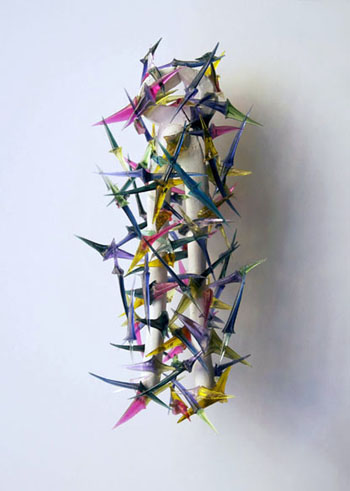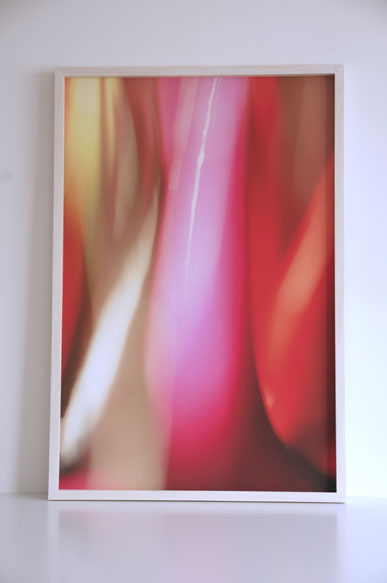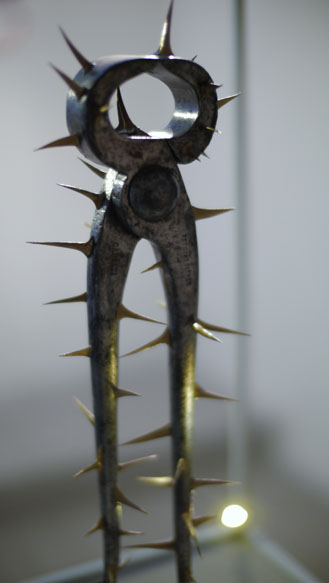Alain Duchesne, is an unclassifiable artist with an exceptional career
behind him and a dual regard, that of an expert in manipulating images,
and that of a poet.
Outstanding this experienced visual artist certainly is, for he has only
chosen to exhibit his work after having filtered it exhaustively through
his own human and technical experiences. We are clearly struck by the
coherence of his aesthetical expression, which over and above its
formal seduction, invites us to look behind the scenes. Duchesne is an
artist who makes fundamental statements using forcerful methods.
His expression has its origins in his perfectly assumed poetic fragility
and his long experience as an art director in the field of advertising,
it immediately engages all our sense, sometimes however causing us
to wince. He invites us to reflect deeply on the image, work, man as
a consumer and as a consumable. He is in fact essentially calling on
us question the instrumentation and suffering of man who, becoming
aware of his exploitation and solitude, refuses to consume the
ready-made ideas of this communicating society and is faced his own
anguish and ultimately his own death.
Drawing from an impressive corpus of media, he has created
different series of works in which each piece is possessed by his main
very personal and committed theme of terrible beauty, symbolized
by the "sublime thorns". The impact of his discourse owes much
to the perfection of its execution which highlights the extraordinary
paradox between the seriousness of his subject and the seduction
of the finished object.
Hand-drawing and visual art (Ecole Estienne, Paris) have always been
part of Duchesne's life: intimate works very early on initiated by his
anguished relationship with the world, and later creative visual
art projects for the most important advertising agencies and luxury
brands. His extreme sensitivity which developped following a series
of ruptures, has transmuted into an art form of great precision,
making him both a conceptual and emotional creator.
Ruptures as a child with the illusion of invulnerability when after
a series of accidents he discovers the terrible heady lure and the
poisonous beauty of ripped flesh, and the inexpressible fragility
of life perpetually balanced with death. Ruptures within his family
which have led to art becoming for him a vector of intimate
commitment. And finally professionnel ruptures when he decided
to use his advertising know-how to question new forms of work
organization which turn the "new working man" into a broken
man in state of panic, a slave without a master.
behind him and a dual regard, that of an expert in manipulating images,
and that of a poet.
Outstanding this experienced visual artist certainly is, for he has only
chosen to exhibit his work after having filtered it exhaustively through
his own human and technical experiences. We are clearly struck by the
coherence of his aesthetical expression, which over and above its
formal seduction, invites us to look behind the scenes. Duchesne is an
artist who makes fundamental statements using forcerful methods.
His expression has its origins in his perfectly assumed poetic fragility
and his long experience as an art director in the field of advertising,
it immediately engages all our sense, sometimes however causing us
to wince. He invites us to reflect deeply on the image, work, man as
a consumer and as a consumable. He is in fact essentially calling on
us question the instrumentation and suffering of man who, becoming
aware of his exploitation and solitude, refuses to consume the
ready-made ideas of this communicating society and is faced his own
anguish and ultimately his own death.
Drawing from an impressive corpus of media, he has created
different series of works in which each piece is possessed by his main
very personal and committed theme of terrible beauty, symbolized
by the "sublime thorns". The impact of his discourse owes much
to the perfection of its execution which highlights the extraordinary
paradox between the seriousness of his subject and the seduction
of the finished object.
Hand-drawing and visual art (Ecole Estienne, Paris) have always been
part of Duchesne's life: intimate works very early on initiated by his
anguished relationship with the world, and later creative visual
art projects for the most important advertising agencies and luxury
brands. His extreme sensitivity which developped following a series
of ruptures, has transmuted into an art form of great precision,
making him both a conceptual and emotional creator.
Ruptures as a child with the illusion of invulnerability when after
a series of accidents he discovers the terrible heady lure and the
poisonous beauty of ripped flesh, and the inexpressible fragility
of life perpetually balanced with death. Ruptures within his family
which have led to art becoming for him a vector of intimate
commitment. And finally professionnel ruptures when he decided
to use his advertising know-how to question new forms of work
organization which turn the "new working man" into a broken
man in state of panic, a slave without a master.


Duchesne's work is indeed a paradox :
- between a primitive tool,craft work a perfect industrial but seductive
finish (Discarded and Suffering at Work series)
- between the idea of his own life filled with despair and its transposition
into familiar amusing gourmand objects (Preserved Decline series)
- between a dream-like universe confined to minimalistic
Micro-Rêveries and its transposition into immense and beautiful
photographs for collectors to hang on their walls (Out Of Focus series)
- and finally the omnipresence of the thorn, a magnificent ode to
the sublime beauty of pain presented in as many colours as series.
The thorn, like a Penone, is an instrument which represents his
bristling perception of his and our world and which has enabled him
to create a universe of beauty in itself. A real organic and prolific
museum which takes possession of each piece- each one a little gem
of "haute-orfèvrerie" which he has tirelessly shaped and reshaped.
A paradox certainly, but not a contradiction, because Duchesne is one
and the same person : we cannot separate his creative work in
advertising from that of his work as a committed visual artist and poet,
one nourishes the other. How lucky we are to have this master
of communication, who from the other side of the mirror not only
projects us into his own sensitive universe, but also takes care
to prepare the ground for us understand how to decipher the images
and their insidious power of seduction.
Alain Duchesne's work is all about expressing suffering
with words of seduction.
- between a primitive tool,craft work a perfect industrial but seductive
finish (Discarded and Suffering at Work series)
- between the idea of his own life filled with despair and its transposition
into familiar amusing gourmand objects (Preserved Decline series)
- between a dream-like universe confined to minimalistic
Micro-Rêveries and its transposition into immense and beautiful
photographs for collectors to hang on their walls (Out Of Focus series)
- and finally the omnipresence of the thorn, a magnificent ode to
the sublime beauty of pain presented in as many colours as series.
The thorn, like a Penone, is an instrument which represents his
bristling perception of his and our world and which has enabled him
to create a universe of beauty in itself. A real organic and prolific
museum which takes possession of each piece- each one a little gem
of "haute-orfèvrerie" which he has tirelessly shaped and reshaped.
A paradox certainly, but not a contradiction, because Duchesne is one
and the same person : we cannot separate his creative work in
advertising from that of his work as a committed visual artist and poet,
one nourishes the other. How lucky we are to have this master
of communication, who from the other side of the mirror not only
projects us into his own sensitive universe, but also takes care
to prepare the ground for us understand how to decipher the images
and their insidious power of seduction.
Alain Duchesne's work is all about expressing suffering
with words of seduction.
Here is a man who discovers the pincers of his farrier grandfather.
He adorns them with acacia thorns which he covers with gold.
The pincers were used to free worn-out horseshoes which exposed
the raw hooves.
Other pincers once removed the nails from the flesh of a crucified man.
And now delicate, precious thorns hinder the use of the tool.
He reflects on his work which affects, torments him.
Moreover the French word 'travail" comes from "tripalium" the latin
for an instrument of torture.
So the pincers, an essential working tool, no longer have a soothing effect.
At the same time, they have acquired an aesthetic lightness.
To use them would cause pain.
At the same time, using them would damage their thorny beauty.
He points out to me the heart-shape formed by the tool's jaws.
This bare contour is now spiked with vegetal defences.
Like others, they are sharp but fragile.
Rather an image of pain than pain itself.
Which restores to work its benevolence.
Ingrid Ernst

ALAIN DUCHESNE
HOME